|
|
|
|
|
|
Welcome to The Storytellers, a monthly newsletter of outstanding children’s literature to read and read aloud from preschoolers to teens.
The best children's books are filled with imagination and fun. Stories that take children into a world of delight and adventure present storytelling at its best. Children need stories for pleasure, laughter and fun; imaginative and nonsensical stories that may not have a scrap of useful information or lesson, but cheerful and delightful lunacy. Give as many as possible to your children, because imagination and fund are essential to life.
Spring is here and what better time to enjoy stories full of laughter, fun, and adventure.
For more information on reading to children and great books to read and read aloud, log on to our web site at www.tchliteracy.com. Always remember.
Read to your children before they’re too old
to listen and love the stories you hold.
But after they’re grown, keep reading, no worries,
they’ll never grow tired of hearing great stories.
The Children’s Hour ©2023.
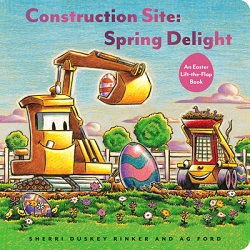
CONSTRUCTION SITE: SPRING DELIGHT
(An Easter Lift-the-Flap Book)
written by Sherri Duskey Rinker, illus. by A. G. Ford, (Chronicle Books, $12.99, 2022, ISBN 978-1-7972-0431-4), 16p, Ages 2-4
“As great big trucks begin their day, / warm sunshine melts the snow away. / The cold, gray days have finally passed. / Hooray! Now, spring is here, at last!”
With wide smiles, seven trucks begin their workday and as they do, readers and listeners will discover spring surprises on each page— a mother chicken and her chicks, a robin and her babies, beautiful flowers by the side of the road, baby lambs, bunnies, and a surprise under the last flap. “When work is finished for the day, / the trucks ask their new friends to stay.” Kids who love trucks, animals, and surprises will love this interactive Easter board book.
Themes: Adventure, Animals, Machines, Rhythm & Rhyme, Series
Other Books in the Series: Construction Site: Road Crew Coming Through! | Three Cheers for Kid McGear! | Mighty, Mighty Construction Site! | Goodnight, Goodnight, Construction Site! | Steam Train, Dream Train | Construction Site: Merry and Bright | Construction Site on Christmas Night | Construction Sire Mission: Demolition
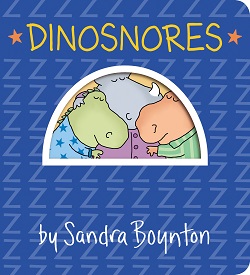
DINOSNORES
written/illus. by Sandra Boynton (Boynton Bookworks, ($7.99, 2019, ISBN 978-1-6659-2496-2), 24p, Ages 3+
Told in rhyme, kids will slip off to dreamland after listening to this cute story of the bedtime ritual of several dinosaurs. “When the sun has gone down and the blue stars appear / Then the dinosaurs know that their bedtime is near.” They
brush their teeth, wash their faces, stretch, put on their pajamas, yawn, close their eyes, settle down to sleep, and dreamland. Then, the loud snoring begins. ‘HONK SHOOOOOO!” all through the night. Kids will love the silliness of Sandra Boynton books, especially two little bunnies, who are glad the noise is very far away.
Themes: Animals, Bedtime, Dinosaurs, Humor, Rhythm & Rhyme, Series
Other Books in the Series: On Board | Pajama Time! | Hey! Wake Up! | Snuggle Puppy! | Birthday Monsters! | Barnyard Dance! | Fifteen Animals! | Perfect Piggies! | Tickle Time! | Belly button Book! | One, Two, Three! | Bunny Rabbit Show! | Your Personal Penguin | Oh My Oh My Oh Dinosaurs! | EEK! Halloween! | Woodland Dance! Peekaboo Rex!
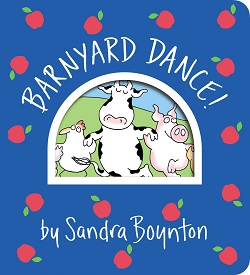
BARNYARD DANCE!
written/illus. by Sandra Boynton (Boynton Bookworks, ($7.99, Sept. 2022, ISBN 978-1-6659-2495-5), 24p, Ages 3+
Sandra Boynton’s wacky barnyard animals begin a high-spirited dance as they bow to one another, twirl, bounce, strut, spin, and, “With a BAA and a MOO and COCKADOODLEDOO / everybody promenade two by two!” While a cow in sunglasses plays a fiddle, the horses prance, mice skitter, sheep slide, little chicks cheep, turkeys trot, frogs leap, and the barnyard dog spins. After their laugh out loud messages and lively stomping, they wave goodbye “With an OINK and a MOO and a QUACK QUACK QUACK, / the dance is done but we’ll be back!” Kids will love the cute animals, the fiddle-playing cow, and might just join in the fun by stomping their feet and clapping their hands.
Themes: Animals, Concept, Humor, Rhythm & Rhyme, Series
Other Books in the Series: On Board | Pajama Time! | Hey! Wake Up! | Snuggle Puppy! | Birthday Monsters! | Dinosnores | Fifteen Animals! | Perfect Piggies! | Tickle Time! | Belly button Book! | One, Two, Three! | Bunny Rabbit Show! | Your Personal Penguin | Oh My Oh My Oh Dinosaurs! | EEK! Halloween! | Woodland Dance! Peekaboo Rex!
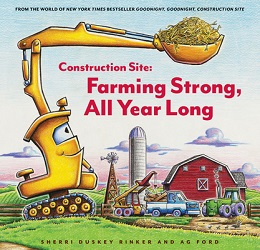
CONSTRUCTION SITE:
FARMING STRONG, ALL YEAR LONG
written by Sherri Duskey Rinker, illus. by A. G. Ford, (Chronicle Books, $17.99, Nov. 2022, ISBN 978-1-7972-1387-3), 16p, Ages 3-7
Spring has arrived and the six beloved trucks from the Construction Site series, Excavator, Bulldozer, Skid Steer, Crane Truck, Dump Truck, and Cement Mixer,
help on a busy farm to repair a road, prepare the ground for planting, plant crops, and repair pens for the animals. In Summer they help water the crops, bale the hay and wheat, dig holes for posts, haul away debris, pour cement, and build a barn.
As the days grow cooler and Fall sets in, they help harvest the crops, haul the grain to town, and harvest the pumpkins. In Winter the snow needs clearing, the roof need fixing, and they help bale the hay. “For friends they have and work they do, / for sunshine, rain, and crops that grew. / All set for springtime days ahead. / But now it’s nighttime. Time for bed.”
Themes: Adventure, Rhythm & Rhyme, Machines, Series
Other Books in the Series: Construction Site: Road Crew Coming Through! | Three Cheers for Kid McGear! | Mighty, Mighty Construction Site! | Goodnight, Goodnight, Construction Site! | Steam Train, Dream Train | Construction Site: Merry and Bright | Construction Site on Christmas Night | Construction Sire Mission: Demolition
|
| |
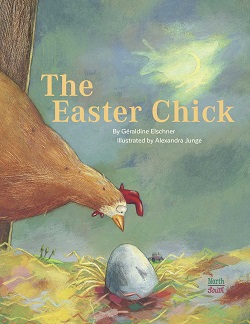
THE EASTER CHICK
written by Géraldine Elschner, illus. by Alexandra Junge, translated by Marianne Martens, (NorthSouth Books, $17.95, March 2022, ISBN 978-0-7358-4474-2), 32p, Ages 4-8
“Hilda had laid the most beautiful egg, and she fussed over it lovingly. But she was getting a little worried. Weeks had passed, and still her baby hadn’t hatched. Suddenly she heard a little voice. ‘Mother, when is Easter?’” Hilda is more than shocked by the little voice but is determined to find the answer. Visiting Max, the owl, she discovers that three things must happen before Easter arrives, and he will advise her by hooting when they arrive—the first day of Spring, the next full moon, and the next Sunday when church bells ring, it’s Easter.
Kids will enjoy the little chick counting down the days inside the egg, the various hidden pictures throughout the story, mom poking a whole in the egg with a piece of straw for her baby to watch for the moon, and the various cycles of the moon. Adults will enjoy the simple way to establish the date of each Easter. Originally published in 2004, this clever story around Easter will entertain all.
Themes: Animals, Families, Heroes, Holidays, Humor
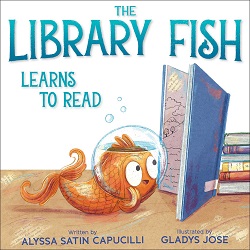
THE LIBRARY FISH LEARNS TO READ
written by Alyssa Satin Capucilli, illus. by Gladys Jose, (Simon & Schuster/Paula Wiseman Books, (Feb. 2023, $18.99, ISBN 978-1-5344-7707-0), 32p, Ages 5-8
“Library Fish loved her home on the desk of Mr. Hughes, the librarian. It was the perfect place to welcome every visitor to the library. From where she sat, Library Fish could check each book that was borrowed and returned.” But she especially loved Storytime when Mr. Hughes read to the children.
When he shares a book about a dog learning to read, a whole new world opens up for the Library Fish, and she is captivated and determined to learn to read. “Hour after hour, night after night, she made sure she knew every letter and each sound it made. F for fish was one of her favorites. Z-z-z-z’s were always welcome after a long night’s work.” Finally, after long nights, she is now an official reader and is delighted to share with her friend, the Bookmobile. Kids will enjoy this cute, extraordinary small fish and the joy she found in learning to read.
Themes: Adventure, Animals, Heroes, Libraries
Other Book in the Series: The Library Fish
|
| |
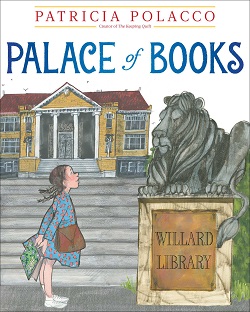
PALACE OF BOOKS
written/illus. by Patricia Polacco, (Paula Wiseman/Simon & Schuster Books for Young Readers, $18.99, March 2023, ISBN 978-1-5344-5131-5), 56p, Ages 7-10
Patricia Polacco reminisces of the time when her family moved to Battle Creek, Michigan, where she meets a kind librarian, Mrs. Creavy, who introduces her to the wonders of the library and its amazing books about birds that she loves. Upon discovering the books of John James Audubon, famous for his paintings of nature and birds, she is overwhelmed, and it is Mrs Creavy who helps her to become the first member of the Audubon bird club of Fremont Elementary. Kids who love birds and libraries will appreciate this interesting story.
Themes: Adventure, Friendship, Libraries
|
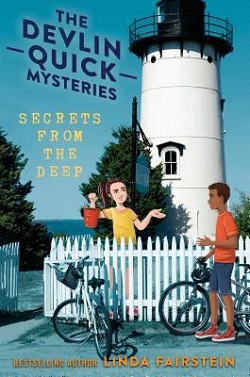
SECRETS FROM THE DEEP #3
(The Devlin Quick Mysteries)
written by Linda Fairstein, (Dial Books, $16.99, 2018, ISBN 978-0-399-18649-3), 288p, Ages 9-12
“It’s the end of summer, and tween sleuth Devlin Quick is on vacation in Martha’s Vineyard with her best friend Booker’s family. It’s not all fun in the sun, though. Dev has a science project for school: to take a daily sample of water from the Vineyard Sound and submit it to an oceanographic DNA lab. From that, the lab can actually tell you what species of fish have been in those waters.
Then Devlin and her friends scoop up something unexpected—a real gold doubloon from the days when pirates hid treasures along the New England coastline! As the daughter of the New York City Police Commissioner, Dev knows that finders aren’t always keepers, so she’s determined to figure out the doubloon’s rightful owner. But solving that mystery is easier said than done, especially when it turns out that someone on the island wants the doubloon’s secrets to stay buried.” Publishers Synopsis
Themes: Adventure, Friendship, Heroes,
Mysteries, Series
Other in the Series: Into the Lion’s Den #1 | Digging for Trouble #2
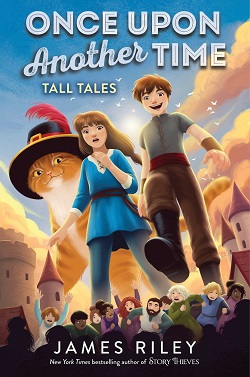
TALL TALES #2
(Once Upon Another Time)
written by James Riley, (Aladdin Books, 2022, $18.99, ISBN 978-1-5344-2590-3), 320p, Ages 9-12
“Lena might finally be accepted by the other giants after she helped defeat the Golden King and his faceless army in the Cursed City, but that doesn’t mean life’s any easier for her. The power-hungry Golden King wants revenge and has begun spreading shadow magic across the kingdoms. His magic takes over the mind of anyone it touches, instilling fear and hatred as it goes.
But Lena and her genie friend, Jin, can handle that, right? Not according to the Last Knight, who changes everything Lena thought she knew about herself by divulging a horrible secret.
And he’s not the only one. The fairy queens—godmothers to some and protectors of the realm—reveal to Lena that, according to the fairies’ The Tales of All Things, she is the only one who can defeat the Golden King and his shadow magic and that she can only do it if she first proves herself worthy.
All Lena ever wanted was to be accepted as she was. But after learning that secret from the Last Knight, she’s not even sure who that is anymore or what it means to be “worthy.” Can she and Jin save the human world that doesn’t trust them, or will they fall prey to shadow magic and doom everything? Knowing how second books tend to go, let’s hope it’s not the latter …” Publishers Synopsis
Themes: Adventure, Folk Literature, Friendship, Heroes, Series
Other in the Series: Once Upon Another Time #1
|
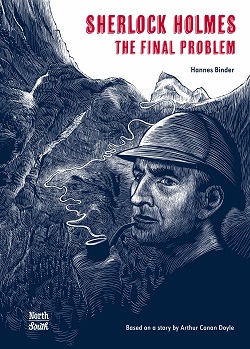
SHERLOCK HOLMES THE FINAL PROBLEM
written by Sir Arthur Conan Doyle, illus. by Hannes Binder, (NorthSouth Books, $18.95, April 2023, ISBN 978-0-7358-4488-9), 56p, Ages 10+
This adaptation of Arthur Conan Doyle’s last planned story in the Sherlock Holmes mystery series is short but stunning with its scratchboard illustrations. Narrated by Dr. Watson, the story begins with a visit by Sherlock Holmes to Dr. Watson, requesting his presence on a journey for a week to the Continent to apprehend Holmes’ archenemy, Professor Moriarty. “He sits like a spider at the center of a giant web of intrigue, spreading wickedness wherever he can. And he is a master of disguise. In brief, Moriarty is a genius of evil, the Napoleon of crime.”
The two men make intricate plans to evade Moriarty and his men on their journey to Switzerland. At the famous Reichenbach Falls in the Alps, the two men are separated by a medical emergency at their hotel, which requires Dr. Watson’s attention. Agreeing to meet later at the hotel, Holmes continues, but when Dr. Watson returns to the Falls, Sherlock has disappeared.
Readers will be astounded by the surreal illustrations that set the tone for this dramatic, graphic retelling of Conan Doyle’s supposedly last Sherlock Holmes mystery. End pages feature information of Arthur Conan Doyle’s mysteries after “The Final Problem” and a short biography of Sir Arthur Conan Doyle.
Themes: Adventure, Friendship, Graphic Novel, Mysteries
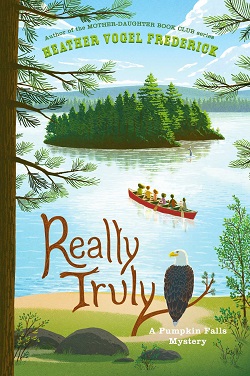
REALLY TRULY: A Pumpkin Falls Mystery #3
written by Heather Vogel Frederick, (Simon & Schuster Books for Young Readers, 2020, ISBN 978-1-5344-1437-2), 368p, Ages 10-13
“Truly Lovejoy is excited for the perfect summer in Pumpkin Falls, New Hampshire: swim practice outside, working at the family bookstore, one-on-one time with her mom, and best of all, time with the dreamy R. J. Calhoun who may just like Truly back. But her plans fall apart when she’s sent off to mermaid academy—sparkly tail and all.
Luckily, a mystery is never too far behind the Pumpkin Falls Private Eyes, and this one might just encourage Truly to come out of her shell, in more ways than one.” Publishers Synopsis.
Themes: Adventure, Families, Mysteries, Series
Other Books in the Series: Absolutely Truly #1 | Yours Truly #2
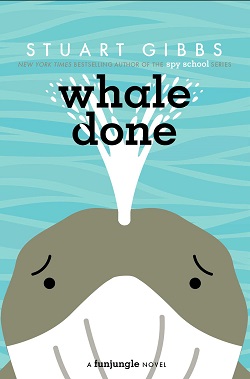
WHALE DONE #8 (FunJungle Series)
written by Stuart Gibbs, (Simon & Schuster Books for Young Readers, $17.99, Feb. 2023, ISBN 978-1-5344-9931-7), 320p, Ages 10-13
“After an escaped kangaroo starts a fire that burns down his house, Teddy Fitzroy accepts an invitation to go to Malibu with his girlfriend, Summer, and her mother, Kandace. He’s hoping to spend some time relaxing on the beach, but wherever Teddy goes, trouble isn’t far behind.
First, a massive dead whale has washed up on the beach—and before anyone can determine what killed it, it explodes. Doc, the head vet from FunJungle, suspects something fishy is going on and ropes Teddy and Summer into helping him investigate.
Then Teddy stumbles upon yet another mystery involving tons of stolen sand. And the paparazzi start spreading rumors about Summer dating a celebrity, leaving Teddy to question their relationship.
Without Summer a his trusted partner, can Teddy navigate the rough waters of this glitzy world and uncover what’s going on?” Publishers Synopsis
Themes: Adventure, Friendship, Humor, Mysteries, Series
Other Books in the Series: Belly Up #1 | Poached #2 | Big Game #3 | Panda-monium #4 | Lion Down #5 | Tyrannosaurus Wrecks #6 | Bear Bottom #7
|
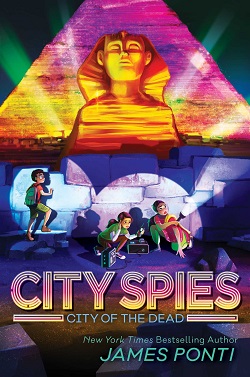
CITY SPIES: City of the Dead #4
written by James Ponti, (Aladdin, $18.99, Feb. 2023, ISBN 978-1-6659-1157-3), 400p,Ages 12+
This fourth installment of The City Spies series finds the five young MI6 Secret Agents investigating a series of cyberattacks at the London British Museum. Kat, the quietest of the five young spies and known for her logic and patterns in chaos, takes charge of the mission. Following clues and deciphered messages, Kat and her now adopted sisters and brothers travel from London to Berlin and ultimately to Egypt’s Valley of the Kings and the City of the Dead, hot on the heels of the suspected enemy, Umbra.
A surprising addition to the team suddenly appears and the City Spies must learn to accept him. Readers will enjoy the interesting history surrounding the discovery of the Egyptian boy king, Tutankhamen’s tomb, the undercover taxi driver, and, of course, the Motherisms.
Themes: Adventure, Families, Friendship, Heroes, Humor, Mysteries, Series, Suspense
Other Books by Author: City Spies #1 | Golden Gate #2 | Forbidden City #3
|
StoryKeepers
Stories from the Past to Read, Share, and Treasure
These are magical stories that take children into a world of delightful imagination, adventure, and fun. They represent storytelling at its best.
SPRING
|
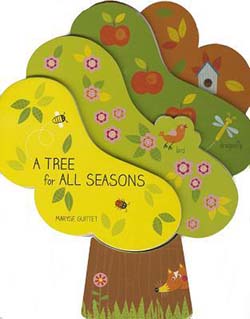
A TREE FOR ALL SEASONS
written/illus. by Maryse Guittet, (Twirl, 2014), 8p, Ages 3+
Young children will enjoy the seasons in all their splendor presented in this tree-shaped board book. Birds, bees, ladybugs, butterflies, flies, caterpillars, dragonflies, and spiders flit through the trees, while questions on the flaps ask, “Who’s hiding here?”, “Who is munching these apples?”, “Who is making that crunching sound?”, and Who’s there?” This colorful and attractive board book is a great introduction for little ones to the yearly seasons.
Themes: Concept, Nature, Seasons
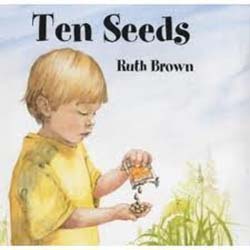
TEN SEEDS
written & illus. by Ruth Brown, (Knoph Books for Young Readers, 2001), 24p, Ages 3-6.
Touching on the number concept as well as the stages of a plant, children learn, in a fascinating way, the number of creatures that are found in the garden, plus how ten seeds can multiply. When a little boy plants 10 seeds, they are subsequently reduced by an ant lifting out a seed, a pigeon picking up a seed with is rootlets, a mouse digging one with longer roots, a slug eating one, a mole burrowing under the roots, and a cat clawing one up. Of the four remaining seeds, three are taken out by a ball, dog, and greenflies, but the lone survivor seed blossoms into a beautiful sunflower, which produces 10 more seeds.
Themes: Classic, Concept, Nature
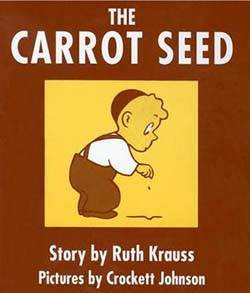
THE CARROT SEED
written by Ruth Krauss, illus. by Crockett Johnson, (HarperCollins 1945), 32p, Ages 3+
In spite of his family’s doubts, a young boy plants a carrot seed and believes it will grow, even though he is told by his parents, the competition, and his big brother that it will not. He waters, pulls weeds, and waits, until his patience is rewarded, and it is huge. Published in 1945, this beautiful classic of patience and determination has never gone out of print.
Themes: Classics, Food, Nature
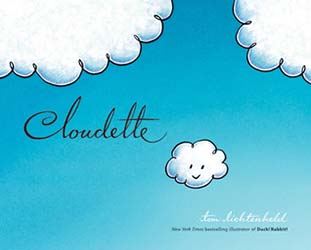
CLOUDETTE
written/illus. by Tom Lichtenheld, (Henry Holt & Co., 2011), 40p, Ages 3-7
Small, content, and happy Cloudette was friendly with birds, squirrels, and kites. She loved watching fireworks, sneaking through tight spaces, and hiding between buildings. However, she longed to do important things like the big clouds that made storms, watered crops, and created mighty rivers. “She wanted to make a garden grow. She wanted to make a brook babble. She wanted to make a waterfall fall. And she thought nothing would be more fun than giving some kids a day off from school.”
When blown from her neighborhood by a huge storm, Cloudette sees a chance to help a small frog, whose pond has dried up. Puffing, rumbling, and raining, she creates a lovely water-filled pond, perfect for frog jumping. According to the author, water was collected during a rainstorm and used for the watercolor illustrations.
Themes: Concept Heroes, Humor, Nature, Values
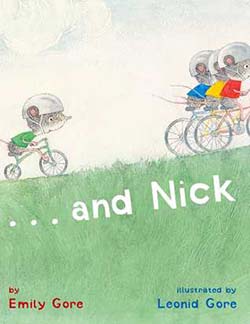
… AND NICK
written by Emily Gore, illus. by Leonid Gore, (Atheneum Books for Young Readers, 2015), 40p, Ages 4-7
Nick, the youngest of four identical brothers, is always trying to catch up. Whatever the activity, Nick always lags behind. Even when picking flowers for Mom, he is left with a “small green sprout.” It turns out that his sprout blooms into the most beautiful flower of all, which Mom labels a “late bloomer.” Family love, patience, and acceptance always makes for the best in read-aloud stories.
Themes: Families, Nature
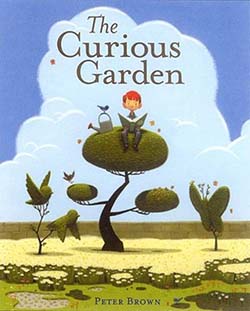
THE CURIOUS GARDEN
written/illus. by Peter Brown, (Little, Brown and Co., 2009), 40p, Ages 4-7
One day while exploring his dreary neighborhood, Liam finds a few flowers on an old, elevated train track. With several hits and misses, he begins watering, weeding, and pruning them. “But this was no ordinary garden. With miles of open railway ahead of it, the garden was growing restless. It wanted to explore.” Over the next few months, the garden expands along the railway and into the drab city. Sidetracked by winter snow, the plants and flowers lay dormant until spring, when they pop up in every conceivable place. New gardens turn up on rooftops, windmills, and ponds along with new gardeners to care for them. The colorful illustrations are fascinating, and the message that one small dream can change the world is what children need to hear.
Themes: Concept, Heroes, Humor, Nature
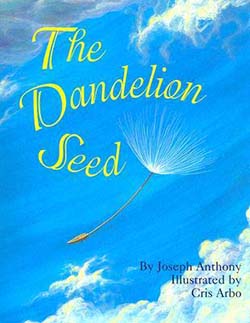
THE DANDELION SEED
written by Joseph Anthony, illus. by Cris Arbo, (DAWN Publishers, 1997), 32p, Ages 6-10
Afraid to leave the garden and venture out into the world, a small reluctant dandelion seed is carried away by the wind across farmland, cities, and lakes arriving as the winter snow begins. When spring comes, the little seed begins to grow and flower, and so begins the lovely cycle once again.
Themes: Nature, Nonfiction, Seasons
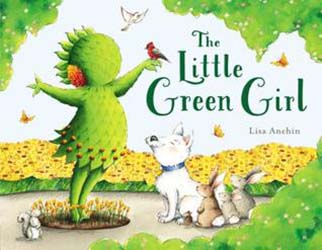
THE LITTLE GREEN GIRL
written/illus. by Lisa Anchin, (Dial Books for Young Readers, 2019), 40p, Ages 4-7
“The Little Green Girl, like so many great things, began as a tiny seed. One bright morning, she unexpectedly blew into Mr. Aster’s garden, and he was just as surprised as she was.” Even though Mr. Aster prefers his normal routine, he places the seedling into the greenhouse, carefully cultivates her, and then moves her into the garden as a topiary. There, the birds tell her about the outside world and faraway places.
Desiring to see for herself, the Little Green Girl tries to convince Mr. Aster of her need to travel by stretching her roots, but he thwarts her every attempt to leave. Find out how the little topiary convinces Mr. Aster to leave his comfort zone, broaden his horizons, and explore the world in this father-daughter friendship/adventure.
Themes: Adventure, Friendship, Humor, Nature
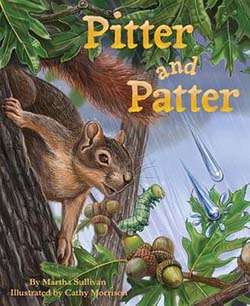
PITTER AND PATTER
written by Martha Sullivan, illus. by Cathy Morrison, (Dawn Publications, 2015), 32p, Ages 4-10
Two raindrops, Pitter and Patter, fall from the sky one day and take quite different paths on their way to the ocean. Pitter lands on a leaf, drips into a stream, and is carried into a valley river, past wetlands, and onto the ocean. During the long journey, Pitter happily greets all the animals in each habitat. “Hello, crayfish. / Howdy snake. / Best wishes for the day, mayfly.” Patter tumbles into a spring meadow with similar greetings to the surrounding animals, “Hello daisy. / Good morning, bee. / Rise and shine, butterfly.” Patter trickles into the soil and spills into an underground cave that flows into a river, which sweeps to the ocean.
There, both are reunited, become warmer, and rejoin a gray cloud. Endpapers describe the water cycle, and offer diagrams, scientific terms, and activities for kids. Martha Sullivan’s clever story of two raindrops and Cathy Morrison’s outstanding illustrations will help kids connect with the water-cycle journey, realize the importance of water to our planet, and teach good manners in the process.
Themes: Adventure, Concept, Nature, Water
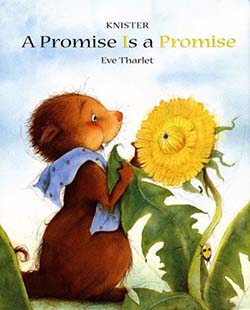
A PROMISE IS A PROMISE
written by Knister, translated by Kathryn Bishop, illus. by Eve Tharlet, (Minedition, 2006/2016), 32p, Ages 4-7
In a sweet story of trust and friendship, a young marmot awakes after a long winter to discover a beautiful dandelion. Over the summer, their friendship grows. They laugh together, play together, and dance together. . . and when it was time to sleep Bruno looked after her.” One day the dandelion asks Bruno for a promise (to blow on her), and she assures him that all will be fine. Bruno fulfills the promise but is heartbroken when he realizes that his friend is gone. Upon awakening the next spring, he discovers hundreds of new dandelions and just as many new friends.
Themes: Friendship, Nature
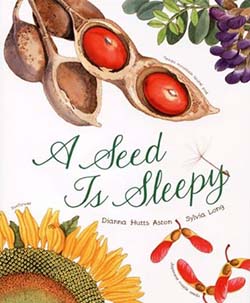
A SEED IS SLEEPY
written by Dianna Hutts Aston, illus. by Sylvia Long, (Chronicle Books, 2007), 40p, Ages 5-10
From the creators of “An Egg Is Quiet” comes another elegant and informative book about seeds. From tiny redwood seeds and hamburger bean seeds to Texas mountain laurel seeds and pods of fluffy milkweed seeds, information is presented on two levels. For younger children, poetic phrases such as “A seed is secretive”; “A seed is fruitful”; “A seed is inventive” are easy to understand.
For older children, science concepts and general information is given in short paragraphs. “Ninety percent of the plants on Earth are flowering plants. Flowering plants produce fruits—fruits of all shapes and textures that keep the seeds cozy until they have found the right place to grow.” A helpful chart depicts various seeds as they grow over days, months, and years into adult plants. Pages filled with attractive illustrations and interesting plant information will surely help children develop an interest in botany.
Themes: Nature, Nonfiction, Seasons, Series
Other Books in Series: An Egg is Quiet | A Nest is Noisy | A Butterfly is Patient | A Rock is Lively
|
|
Over the years, we have researched thousands of children's books, and can recommend some of the best in outstanding children's literature for parents to read aloud and children to read.
Our recommendations must meet certain criteria: fun, creative and imaginative stories, delightful illustrations, and excellent for age appropriate listening and reading. We hope that you enjoyed our recommendations. If you desire further information some of the best in children's literature, please visit our website, www.tchliteracy.com.
CONTACT US:
The Children's Hour
6497 Bellcross Trl
Whitsett, NC 27377
Email: info@tchliteracy.com |
|
|
|
|
|
|